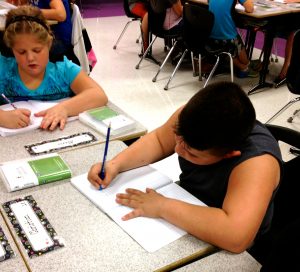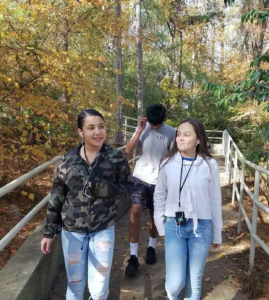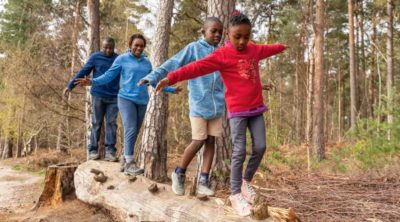It’s finally starting to feel like fall! As leaves change and temperatures drop, your walks will take on a different look and feel. Why not take advantage of the slightly different sensory details that surround you on your strolls? That’s right! Have some fall fun with figurative language.
We’ve even got the perfect podcast to get you started. Explore Simile and Metaphor (4-#11, 5-#72, Complete-#4). All you need to do is grab those WalkKits (or check out The Walking Classroom’s mobile app), and get set to walk, listen, learn, and . . . maybe even write!
Similes in Song? Metaphors in Music?
 Absolutely! Captivate your students with a quick flick on metaphors! Better yet, go ahead and try out one of several videos to help bring figurative language to life. From singing along to the classic Schoolhouse Rock “Telegraph Line” to seeing if they can sense the similes and metaphors in a musical mash-up, your students will be actively engaged!
Absolutely! Captivate your students with a quick flick on metaphors! Better yet, go ahead and try out one of several videos to help bring figurative language to life. From singing along to the classic Schoolhouse Rock “Telegraph Line” to seeing if they can sense the similes and metaphors in a musical mash-up, your students will be actively engaged!
Practice Makes Perfect
To continue your lesson beyond the podcast and assess your students’ understanding at the same time, present some examples! Take advantage of a ready-made worksheet to have students independently identify similes and metaphors.
And . . . additional resources are in abundance! There are a wealth of other figurative language activities and lesson plans on similes and metaphors from which to choose.
Add in Some Alliteration and Personification
Looking for another podcast focusing on figurative language? Check out Alliteration & Personification (5-#67, Complete-#5)! Then, once you’ve added some other types of figurative language to the mix, it’s time to see if students can identify each.
Review and reinforce students’ knowledge with this fun fall printable full of figurative language, or check out this crossword puzzle worksheet (and answers!). For even more language arts and reading resources, check out Education.com!
Bring in a Book . . . or Two!
 Books provide a wealth of additional examples of similes and metaphors for your students, and there are plenty of textx from which to pick. Looking for more direct explanation? Check out Skin Like Milk, Hair of Silk: What are Similes and Metaphors? by Brian P. Cleary for an cleverly-written take on the topic!
Books provide a wealth of additional examples of similes and metaphors for your students, and there are plenty of textx from which to pick. Looking for more direct explanation? Check out Skin Like Milk, Hair of Silk: What are Similes and Metaphors? by Brian P. Cleary for an cleverly-written take on the topic!
Searching for something a little more literary? Picture books are the perfect path if you’re seeking an abundance of examples in one place.
 Best of all, there already-created lists of picture books with similes and picture books with metaphors! All you have to do is choose! From among these books, it appears that the most popular pick is the Caldecott winner, Owl Moon, written by Jane Yolen and illustrated by John Schoenherr. You can even find a lesson plan to support you!
Best of all, there already-created lists of picture books with similes and picture books with metaphors! All you have to do is choose! From among these books, it appears that the most popular pick is the Caldecott winner, Owl Moon, written by Jane Yolen and illustrated by John Schoenherr. You can even find a lesson plan to support you!
Need some help keeping all those figurative language finds straight? Perhaps a graphic organizer is what you need to sort things out! This graphic organizer has students find a simile or metaphor, then write and illustrate the literal meaning as well!
 Ready to Write?
Ready to Write?
Take another opportunity to walk, with notebook and writing implement in hand this time. Encourage your students to jot down what they hear, see, feel, and smell on their autumnal jaunt. Have them work with a partner work these details into similes or metaphors.
They can then craft a paragraph (or a poem!), incorporating three to five of their similes or metaphors in the end product. Be sure to allow time for students to share their creations!
Looking for some additional ideas? Check out this creative writing lesson plan!





Leave a Reply